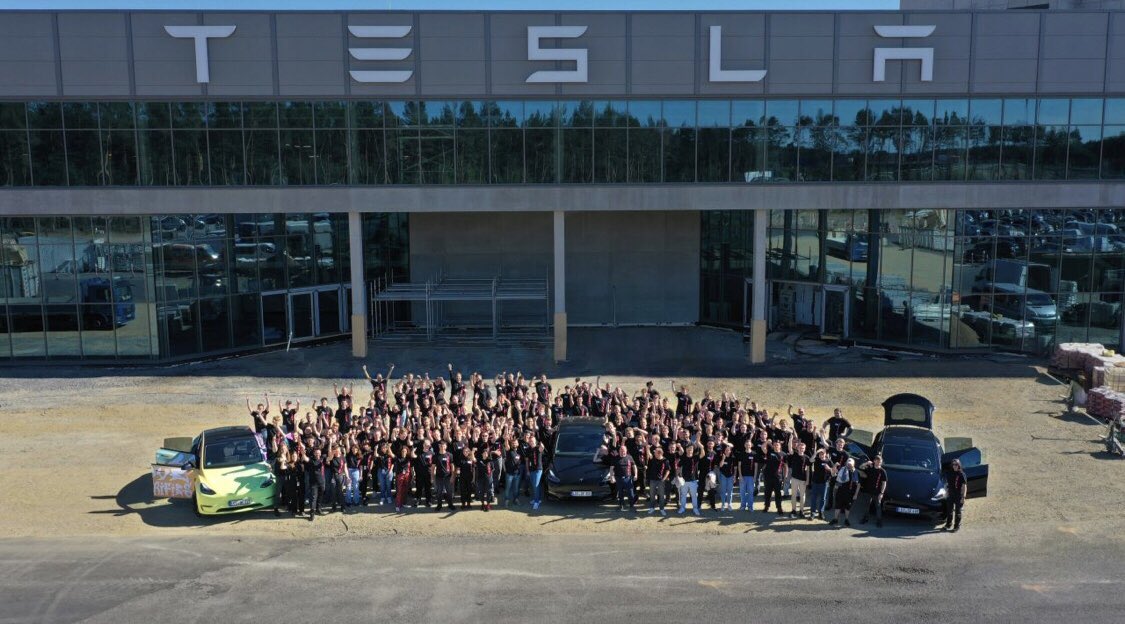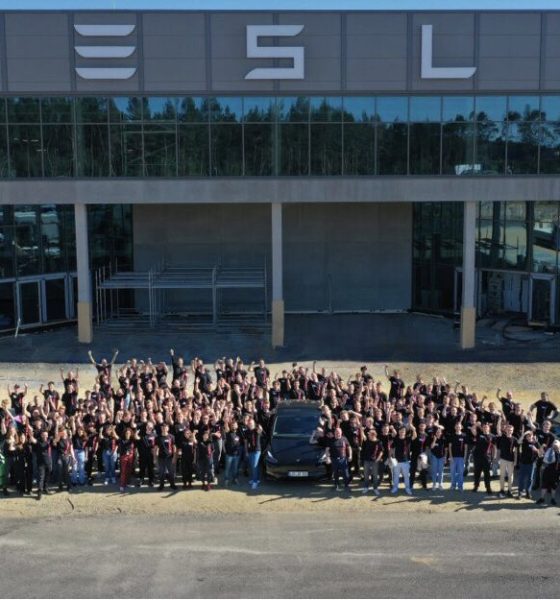Tesla’s factory in Grünheide, Germany officially opened last year, and the site has since accumulated around 11,000 workers. According to a new post from Tesla’s Recruiting account on X, the automaker has also hired as many as 60 deaf people to work at the Gigafactory outside of Berlin.
The Brandenburg Gigafactory has so far hired 60 deaf employees, many of whom are Ukrainians who fled the ongoing Russian invasion, according to the new Tesla Recruiting account on X in a post on Sunday. The post includes a video introducing viewers to a few of the factory’s deaf employees, including Amaliia, Ihor and Andrii.
At Tesla, everyone can have meaningful impact, no matter their background or disability.
To date, 60 deaf employees are part of the Giga Berlin team—a large portion being Ukrainians who fled the war.
→ https://t.co/KZM7yOtpqz pic.twitter.com/GD0oe4WxP1
— Tesla Recruiting (@TeslaRecruiting) September 24, 2023
The video also includes excerpts from some of the non-deaf employees about their experiences having deaf coworkers on the team.
“We don’t just talk about inclusion and diversity, we simply live it,” says general assembly supervisor Holger in the video. “For me there are no employees with disabilities, they are simply employees.”
One associate manager in the drive unit, Juri, says that the process of recruiting deaf employees began when he was asked if he could integrate five people who were deaf. After starting with just one employee who was deaf, that employee told a number of other deaf people about the job who would later go on to join the team.
Amaliia, a drivetrain production associate who is deaf, says she brought her family from Ukraine when the war began. Her family was invited to Germany by a friend of her husband’s who already worked at Tesla, and the friend also asked her to join the team at Giga Berlin. She says the team has been welcoming and describes Tesla’s team spirit as “fantastic.”
Other deaf employees featured in the video include Ihor, a production associate in the drive unit department of the factory, and Andrii, a production associate in general assembly. Andrii says he was recruited by the general assembly supervisor, Rene, who personally recruited many of the Ukrainian colleagues.
The video also includes a moment with the drive unit supervisor Simone, who says that many of the company’s non-deaf employees have already learned a few words in sign language.
One user in the X thread said that he had previously been interviewed at Tesla’s Gigafactory Texas, though the company shared concerns that a deaf person wouldn’t be able to hear production line sound systems. The user followed up in the thread, asking if he would be able to have another shot at interviewing for a different area of the Austin, Texas factory.
Tesla debuted its Recruiting page on X earlier this month, and this post is only the account’s second, following a repost of a video from the company’s Optimus account.
The post also included a link to Tesla’s Giga Berlin web page, and you can find Tesla’s open positions at the factory here.
The news comes just a few days after a German minister called Tesla the “driving force” behind economic growth in the state of Brandenburg, primarily due to Giga Berlin and its production ramp-up. It also comes after some criticism has been lodged against Giga Berlin by German union IG Metall, with the union most recently alleging that workers were being forced to work excessive hours.
Tesla is currently in the process of gaining approval for expansions at Giga Berlin, set to boost production capacity from 50 GWh to 100 GWh.
Tesla Giga Berlin promotes its free “Giga Train” shuttle for its employees
What are your thoughts? Let me know at zach@teslarati.com, find me on X at @zacharyvisconti, or send your tips to us at tips@teslarati.com.

Elon Musk
Starlink passes 9 million active customers just weeks after hitting 8 million
The milestone highlights the accelerating growth of Starlink, which has now been adding over 20,000 new users per day.

SpaceX’s Starlink satellite internet service has continued its rapid global expansion, surpassing 9 million active customers just weeks after crossing the 8 million mark.
The milestone highlights the accelerating growth of Starlink, which has now been adding over 20,000 new users per day.
9 million customers
In a post on X, SpaceX stated that Starlink now serves over 9 million active users across 155 countries, territories, and markets. The company reached 8 million customers in early November, meaning it added roughly 1 million subscribers in under seven weeks, or about 21,275 new users on average per day.
“Starlink is connecting more than 9M active customers with high-speed internet across 155 countries, territories, and many other markets,” Starlink wrote in a post on its official X account. SpaceX President Gwynne Shotwell also celebrated the milestone on X. “A huge thank you to all of our customers and congrats to the Starlink team for such an incredible product,” she wrote.
That growth rate reflects both rising demand for broadband in underserved regions and Starlink’s expanding satellite constellation, which now includes more than 9,000 low-Earth-orbit satellites designed to deliver high-speed, low-latency internet worldwide.
Starlink’s momentum
Starlink’s momentum has been building up. SpaceX reported 4.6 million Starlink customers in December 2024, followed by 7 million by August 2025, and 8 million customers in November. Independent data also suggests Starlink usage is rising sharply, with Cloudflare reporting that global web traffic from Starlink users more than doubled in 2025, as noted in an Insider report.
Starlink’s momentum is increasingly tied to SpaceX’s broader financial outlook. Elon Musk has said the satellite network is “by far” the company’s largest revenue driver, and reports suggest SpaceX may be positioning itself for an initial public offering as soon as next year, with valuations estimated as high as $1.5 trillion. Musk has also suggested in the past that Starlink could have its own IPO in the future.
News
NVIDIA Director of Robotics: Tesla FSD v14 is the first AI to pass the “Physical Turing Test”
After testing FSD v14, Fan stated that his experience with FSD felt magical at first, but it soon started to feel like a routine.

NVIDIA Director of Robotics Jim Fan has praised Tesla’s Full Self-Driving (Supervised) v14 as the first AI to pass what he described as a “Physical Turing Test.”
After testing FSD v14, Fan stated that his experience with FSD felt magical at first, but it soon started to feel like a routine. And just like smartphones today, removing it now would “actively hurt.”
Jim Fan’s hands-on FSD v14 impressions
Fan, a leading researcher in embodied AI who is currently solving Physical AI at NVIDIA and spearheading the company’s Project GR00T initiative, noted that he actually was late to the Tesla game. He was, however, one of the first to try out FSD v14.
“I was very late to own a Tesla but among the earliest to try out FSD v14. It’s perhaps the first time I experience an AI that passes the Physical Turing Test: after a long day at work, you press a button, lay back, and couldn’t tell if a neural net or a human drove you home,” Fan wrote in a post on X.
Fan added: “Despite knowing exactly how robot learning works, I still find it magical watching the steering wheel turn by itself. First it feels surreal, next it becomes routine. Then, like the smartphone, taking it away actively hurts. This is how humanity gets rewired and glued to god-like technologies.”
The Physical Turing Test
The original Turing Test was conceived by Alan Turing in 1950, and it was aimed at determining if a machine could exhibit behavior that is equivalent to or indistinguishable from a human. By focusing on text-based conversations, the original Turing Test set a high bar for natural language processing and machine learning.
This test has been passed by today’s large language models. However, the capability to converse in a humanlike manner is a completely different challenge from performing real-world problem-solving or physical interactions. Thus, Fan introduced the Physical Turing Test, which challenges AI systems to demonstrate intelligence through physical actions.
Based on Fan’s comments, Tesla has demonstrated these intelligent physical actions with FSD v14. Elon Musk agreed with the NVIDIA executive, stating in a post on X that with FSD v14, “you can sense the sentience maturing.” Musk also praised Tesla AI, calling it the best “real-world AI” today.
News
Tesla AI team burns the Christmas midnight oil by releasing FSD v14.2.2.1
The update was released just a day after FSD v14.2.2 started rolling out to customers.

Tesla is burning the midnight oil this Christmas, with the Tesla AI team quietly rolling out Full Self-Driving (Supervised) v14.2.2.1 just a day after FSD v14.2.2 started rolling out to customers.
Tesla owner shares insights on FSD v14.2.2.1
Longtime Tesla owner and FSD tester @BLKMDL3 shared some insights following several drives with FSD v14.2.2.1 in rainy Los Angeles conditions with standing water and faded lane lines. He reported zero steering hesitation or stutter, confident lane changes, and maneuvers executed with precision that evoked the performance of Tesla’s driverless Robotaxis in Austin.
Parking performance impressed, with most spots nailed perfectly, including tight, sharp turns, in single attempts without shaky steering. One minor offset happened only due to another vehicle that was parked over the line, which FSD accommodated by a few extra inches. In rain that typically erases road markings, FSD visualized lanes and turn lines better than humans, positioning itself flawlessly when entering new streets as well.
“Took it up a dark, wet, and twisty canyon road up and down the hill tonight and it went very well as to be expected. Stayed centered in the lane, kept speed well and gives a confidence inspiring steering feel where it handles these curvy roads better than the majority of human drivers,” the Tesla owner wrote in a post on X.
Tesla’s FSD v14.2.2 update
Just a day before FSD v14.2.2.1’s release, Tesla rolled out FSD v14.2.2, which was focused on smoother real-world performance, better obstacle awareness, and precise end-of-trip routing. According to the update’s release notes, FSD v14.2.2 upgrades the vision encoder neural network with higher resolution features, enhancing detection of emergency vehicles, road obstacles, and human gestures.
New Arrival Options also allowed users to select preferred drop-off styles, such as Parking Lot, Street, Driveway, Parking Garage, or Curbside, with the navigation pin automatically adjusting to the ideal spot. Other refinements include pulling over for emergency vehicles, real-time vision-based detours for blocked roads, improved gate and debris handling, and Speed Profiles for customized driving styles.










